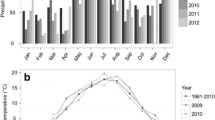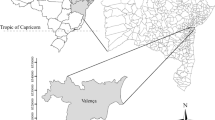Abstract
Trials were established at three sites in Uganda to test the suitability of multipurpose trees (MPTs) as upperstorey in crop lands to provide poles, small timber and fuelwood. The three sites were Kachwekano District Farm Institute (1°16′ S, 29°57′ E, 2000 m.a.s.l.) in Kabale District, Kabanyolo University Farm (0°28′ N, 32°27′ E, 1250 m.a.s.l.) in Mpigi District and Bushenyi District Farm Institute (0°34′ S, 30°13′ E, 1610 m.a.s.l.) in Bushenyi District. The MPTs were planted in single rows at intra spacing of 2 m and each plot contained seven or nine trees. On both sides of the tree row, crops were raised. Data on crop yields were collected every season, while data on the growth of the trees were collected four times each year.
In terms of tree growth,Grevillea robusta, Casuarina cunninghamiana andAlnus acuminata performed well with height growth of 1.8–2.4 m per year at Kachwekano, while at BushenyiGrevillea robusta, Casuarina junghuhniana, Cupressus lusitanica andCedrela serrulata averaged 1.6–2.0 m height per year. At Kabanyolo,Melia azedarach, Cassia siamea, Jacaranda mimosifolia, Grevillea robusta andMaesopsis eminii had height increments ranging from 1.8–2.7 m annually. Crop yields were affected by the presence of the MPTs, withMaesopsis eminii being the most competitive (averaging 60% reduction, over five seasons). The crop rows nearest to the tree line were the most affected. OnlyAlnus acuminata seems to have had a positive effect on crop yields. The installation of a root mesh to reduce tree root competition for nutrients and water in four species increased yields in plots with MPTs by 5% (Melia azedarach) to 152% (Maesopsis eminii), but the control plot still had significantly higher bean yields, suggesting that shading could also be important. In the case of maize, suppression seems to be due mainly to root competition because after its elimination yields obtained thereafter did not differ significantly from those of the control except for the Maesopsis plots. The negative influence of the MPTs could, therefore, be minimized by periodically pruning the tree crowns and roots.
Similar content being viewed by others
References
Allen JC and Barnes DF (1984) The causes of deforestation in developing countries. Assoc Am Geogr 22:163–184
Burnett GN (1985) Kenya's forests: going up in smoke. Western Wildlands 11:25–27
Buschbacher RJ (1986) Tropical deforestation and pasture development. BioScience 36:22–28
Forestry Research centre (1986) Growth of some forest trees in Ethiopia and suggestions for species selection in different climatic zones. Research Note 2. Addis Ababa, Ethiopia
Campbell CD (1989) The importance of root interactions for grass and tree in a silvo-pastural system. Aspects Appl Biol 22:255–261
Gillespie AR (1989) Modelling nutrient flux and interspecies root competition in agroforestry interplantings. Agroforestry Systems 8:257–265
Hamilton A (1984) Deforestation in Uganda. Oxford University Press, Nairobi
Hazra CR and Tripathi SB (1986) Soil properties, micro-metreological parameters, forage yield and phosphorus uptake of berseem as influenced by phosphate application under agroforestry system of production. J. Agron Crop Sci 156:145–152
Incerti M and O'Leary GJ (1990) Rooting depth of wheat in the Victorian mallee. Austr J Expt Agri 30:817–824
Jonsson K, Fidjeland L, Maghembe JA and Hogberg P (1988) The vertical distribution of fine roots of five tree species and maize in Morogoro, Tanzania. Agroforestry Systems 6:63–69
Kang BT, Wilson GF and Spikens L (1981) Alley cropping maize (Zea mays) andLeucaena leucocephala in Southern Nigeria. Plant Soil 63:165–179
Kater LJM, Kante S, and Budelman A (1992) Karite' (Vitellaria paradoxa) and ne're' (Parkia biglobosa) associated with crops in South Mali. Agroforestry Systems 18:89–106
Kessler JJ (1992) The influence of Karite' (Vitellaria paradoxa) and ne're' (Parkia biglobosa) trees on sorghum production in Burkina Faso. Agroforestry Systems 17:97–118
Khybri ML, Gupta RK, Ramsewa and Tomar HPS (1992) Crop yields of rice and wheat grown in rotation as intercrops with three species in the outer hills of Western Himalaya. Agroforestry Systems 17:193–204
Kleinert C (1985) Settlement pressure and the destruction of forests in Rwanda (Eastern Central Africa). Appl Geogr Develop 20:93–106
Lane CL (1988) Evaluation of native and exotic non-leguminous nitrogen fixing species for use as soil improvers in South Carolina. Nitrogen Fixing Tree Research Reports 6:24–25
Laosuwan P, Yeedum I, Sripana P and Sirisongkram P (1988) A study on intercropping of young rubber. I. Yield potential of different intercrops. Thai J Agric Sci 21:179–188
Malaisse F and Binzangi K (1985) Wood as a source of fuel in Upper Shaba (Zaire). Common For Rev 64:227–239
Mathew T, Mohan Kumar B, Suresh Babu KV and Umamaheswaran K (1992) Comparative performance of four multipurpose trees associated with four grass species in the humid regions of Southern India. Agroforestry Systems 17:205–218
Nair PKR (1983) Remarriage of crops and trees. Inter Agri Devel 3:5–8
Newmann IF (1983) Use of trees in small holder agriculture in tropical highlands. In: Lockeret ZW (ed), Environmentally Sound Agriculture, pp 351–374
Okorio J. Study of the rooting patterns of eight multipurpose tree species planted at two sites in Uganda. For Ecol Manage (in preparation)
Okorio J. Comparative effects of some multipurpose trees on soil chemical properties in an intercropping system. Plant Soil (in preparation)
Peden DG, Byenkya S, Wajj N, and Okorio J (1993) Increased crop production withAlnus acuminata in Uganda. Agroforestry Today 5:5–8
Peden DG, Aluma JR, Okorio J, Byenkya S, Wajja N, and Muwanga J (1991) AFRENA PROJECT Uganda. Progress report for the period ending March 1991. AFRENA Report 43. ICRAF, Nairobi, 78 pp
Pimentel D, Dazhong W, Eigenbrode S, Lang H, Emerson D and Karasik K (1986) Deforestation: interdependency of fuelwood and agriculture. Oikos 46:404–412
Prajapati MC, Verma B, Mittal SP, Nambiar KTN and Thippannavar BS (1971) Effect of lateral development ofProsopis juliflora DC roots on agricultural crops. Ann Arid Zone 10:186–193
Prinsley RT and Swift MJ (1986) Amelioration of soil by Trees: A Review of Current Concepts and Practices. Commonwealth Science Council, 181 pp
Pushparajah E and Elliot CR (1990) Use of barriers, alleycropping and agroforestry for sustainable agriculture. In: Pacific Workshop on the Establishment of Soil Management Experiments on Sloping lands. Bangkok, Thailand. International Board for Soil Research and Management, IBSRAM Technical Note no 4
Rao MR, Sharma MM and Ong CK (1990) A study of the potential of hedgerow intercropping in semi-arid India using a two-way systematic design. Agroforestry Systems 11:243–258
Sae-lee S, Vityakon P, and Prachaiyo B, (1992) Effects of trees on paddy bund on soil fertility and rice growth in Northeast Thailand. Agroforestry Systems 18:213–223
Singh RP, Ong CK and Saharan N (1989) Above and below ground interactions in alley cropping in semi-arid India. Agroforestry Systems 9:259–274
Thomas DB (1988) Conservation of cropland on steep slopes in Eastern Africa. In: Moldenhaver WC and Hudson NW (eds) Conservation Farming on Steep Lands. Soil and Water Conservation Society, pp 140–149. Ankey, Iowa
Thorhaug A and Miller B (1986) Endangered tree species in Northern Ethiopia. Environ Conserv 13:71–72
Verinumbe I and Okali DUU (1985) The influence of coppiced teak (Tectona grandis L. F.) regrowth and roots on intercropped maize (Zea mays). Agroforestry Systems 3:381–386
Yamoah C (1991) Choosing suitable intercrops prior to pruning Sesbania hedgerows in an alley configuration. Agroforestry Systems 13:87–94
Zohar Y (1985) Root distribution of an Eucalypt Shelterbelt. For Ecol Manage 12:305–307
Author information
Authors and Affiliations
Rights and permissions
About this article
Cite this article
Okorio, J., Byenkya, S., Wajja, N. et al. Comparative performance of seventeen upperstorey tree species associated with crops in the highlands of Uganda. Agroforest Syst 26, 185–203 (1994). https://doi.org/10.1007/BF00711210
Issue Date:
DOI: https://doi.org/10.1007/BF00711210




